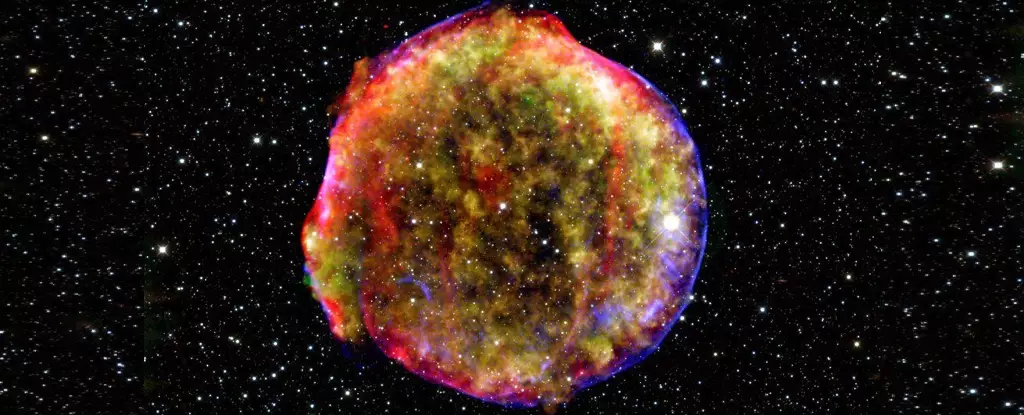In the vastness of our galaxy, a cosmic drama unfolds, one marked by the explosive demise of stars and the enigmatic birth of cosmic rays. As scientists dedicate their lives to unraveling the mysteries surrounding these phenomena, they confront a daunting truth: understanding the forces at play during a supernova is akin to grasping the very essence of the universe itself. Researchers have long pursued the origins of ultra-energetic particles—cosmic rays that strike the Earth with ferocity, challenging our preconceived boundaries of astrophysical knowledge. Could the violent death throes of stars hold the key to unleashing the universe’s most powerful accelerators?
While supernovae have historically been prime suspects in the search for cosmic ray sources, recent analyses have introduced a layer of skepticism. A team of physicists, through intricate numerical simulations, has ventured into the possibility that collapsing stars might indeed serve as cosmic accelerators at unprecedented energy levels. Their research shines a new light on the dynamics of these explosive events, suggesting that there exists a fleeting window of time—an ephemeral moment when a dying star, engulfed in chaos, has the potential to drive particles to extraordinary velocities. However, this revelation is tempered by the realization that such scenarios are contingent upon a set of highly specific conditions.
Magnetic Turbulence: The Key Ingredient
To understand the implications of these findings, one must delve into the magnetic dynamics surrounding a supernova. As a dying star collapses under its own weight, it unleashes a torrent of heat and radiation that interacts vigorously with its outer shell—an amalgamation of gas and stellar remnants. This interaction generates magnetic fields of staggering intensity. However, the pivotal insight from recent studies indicates that while these fields may provide some degree of acceleration, they might pale in comparison to the expectations set by existing theoretical models.
Merely a few thousand light years from Earth, Tycho’s star, a historical supernova, serves as a focal point for this inquiry. It captivated astronomers in 1572 with its sudden brilliance—a cataclysmic explosion that now informs our understanding of stellar evolution. Despite the exhilaration surrounding its study, modern research has revealed that Tycho’s magnetic properties might limit cosmic ray acceleration far more than hoped. Parsing through this dichotomy, scientists face the challenge of reconciling observational data with theoretical constructs.
Could it be that we have overstated the capabilities of star-driven cosmic ray accelerators? If supernovae fail to meet expectations, astrophysicists must confront a radical truth—our understanding of the universe’s high-energy realms could be profoundly incomplete. This realization compels us to question not just the nature of cosmic ray origins but also our methodologies in investigating them.
PeVatrons: The Hunt for the Giants
As researchers navigate this complex tapestry of celestial mechanics, a tantalizing prospect emerges: the existence of PeVatrons, hypothetical engines of cosmic acceleration capable of producing particles on mind-boggling energy scales. These hypothetical entities would account for cosmic rays that vastly exceed what humanity can generate in laboratories. The sheer audacity of attempting to locate these engines amidst the cosmos is matched only by the awe they inspire within the scientific community.
The notion that dying stars might be these elusive PeVatrons is both alluring and troubling. The implications engender a sense of urgency—if collapsing stars can indeed generate particles of epic proportions under certain conditions, then understanding the lifecycle dynamics of these stars becomes paramount. The critical factor, as identified in current research, hinges on the density of the material surrounding the star during its catastrophic end. If conditions align, and the shell is dense enough at the time of the explosion, the resultant shockwave can whip up particles to extraordinary energies. Yet there lies an unsettling truth; the brief window of opportunity may soon close, as it evolves into mere cosmic dust.
As the scientific community anticipates the next astronomical events that could illuminate these questions, a bittersweet acknowledgment arises: the relentless march of time may rob us of potential sources of insight. Future supernovae must be observed and studied at just the right moment following their explosion, lest the powerful cosmic rays vanish into the ether, leaving behind only curiosity and contemplation.
In the pursuit of celestial knowledge, we stand at a thrilling intersection of hope and uncertainty. The very life and death cycles of stars may bear the key to unlocking the universe’s secrets, but with each passing moment, the opportunity slips further from our grasp. As we chart the cosmos and probe the fabric of reality, we must grapple with our limitations—both in understanding and in timing—while remaining steadfast in our determination to uncover the truth behind the cosmos’ most captivating phenomena.



Leave a Reply